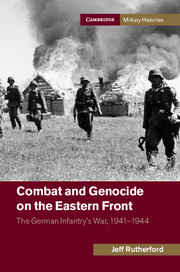Book contents
- Frontmatter
- Table of contents
- List of illustrations
- List of figures
- List of maps
- List of tables
- Acknowledgments
- Introduction
- 1 The Wehrmacht and German society
- 2 Preparations for war
- 3 “Attack with a ruthless offensive spirit and … a firestorm of destruction”
- 4 “Will the continuation of this attackbe worth it?”
- 5 “It is only a question of where, not if, civilians will starve”
- 6 The failure of Operation Barbarossa
- 7 The Soviet winter offensive, 1942
- 8 “The population … shouted out to the interpreter that one would rather be shot instead of being left to starve”
- 9 “From one mess to another”
- 10 “We need to fight to the end, so oder so”
- 11 A more rational occupation?
- 12 “As miserable representatives of themiserable twentieth century, we burnedall of the villages”
- Conclusion
- Bibliography
- Index
- References
3 - “Attack with a ruthless offensive spirit and … a firestorm of destruction”
The opening phase of Operation Barbarossa
Published online by Cambridge University Press: 05 July 2014
- Frontmatter
- Table of contents
- List of illustrations
- List of figures
- List of maps
- List of tables
- Acknowledgments
- Introduction
- 1 The Wehrmacht and German society
- 2 Preparations for war
- 3 “Attack with a ruthless offensive spirit and … a firestorm of destruction”
- 4 “Will the continuation of this attackbe worth it?”
- 5 “It is only a question of where, not if, civilians will starve”
- 6 The failure of Operation Barbarossa
- 7 The Soviet winter offensive, 1942
- 8 “The population … shouted out to the interpreter that one would rather be shot instead of being left to starve”
- 9 “From one mess to another”
- 10 “We need to fight to the end, so oder so”
- 11 A more rational occupation?
- 12 “As miserable representatives of themiserable twentieth century, we burnedall of the villages”
- Conclusion
- Bibliography
- Index
- References
Summary
Drive through Lithuania
At 3:05 in the morning on 22 June 1941, members of the 121st ID crossed the border into the Soviet Union alongside their peers. By the conclusion of the first day of the operation, Leeb noted that the “troops have not yet pushed into any serious resistance.” Such a perspective might have been justified by focusing on the armored groups as German mechanized forces plunged deep into the Soviet Union. For the infantry, however, it was clear that the opening days of the invasion were indeed some of the bloodiest of the first six months of war.
The 121st ID reported that once the initial surprise of the assault passed, Soviet troops defended “stubbornly” in settlements. This proved especially true for II/405th Infantry Regiment, which fought a “very tough battle against numerous small nests and individual soldiers, who, in small bunkers, houses, cellars, barns, etc., often sacrificed themselves [Selbstaufopferung].” An NCO in the engineer battalion admiringly noted that “the Russian is a master in constructing positions,” while another German soldier noted the disquieting fact that “Red Army men defended their positions until the last breath.” Plunging into an area ringed by skillfully defended hedges, the 123rd ID also suffered “relatively high casualties” during the first day of fighting. Such reports of this intense combat eventually bubbled up to the higher echelons of the army, leading Leeb to note four days into the campaign that
the overall impression of the enemy won in the past few days is that he fights very stubbornly, doggedly and, at times, underhandedly, and better than he did in the World War. He is very skilled at camouflage. He gives nothing away, but would rather fight in hopeless situations to the end.
- Type
- Chapter
- Information
- Combat and Genocide on the Eastern FrontThe German Infantry's War, 1941–1944, pp. 84 - 114Publisher: Cambridge University PressPrint publication year: 2014



